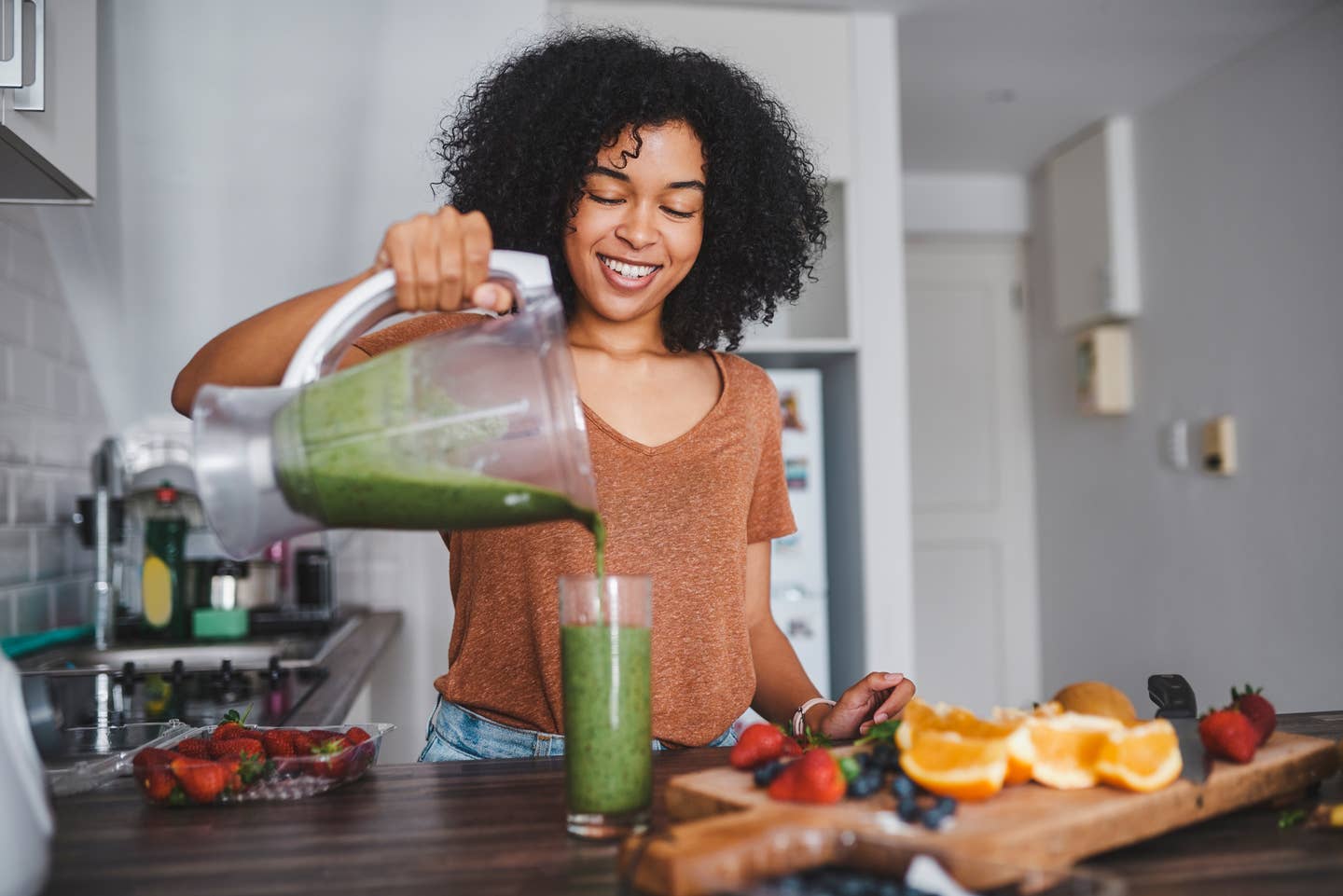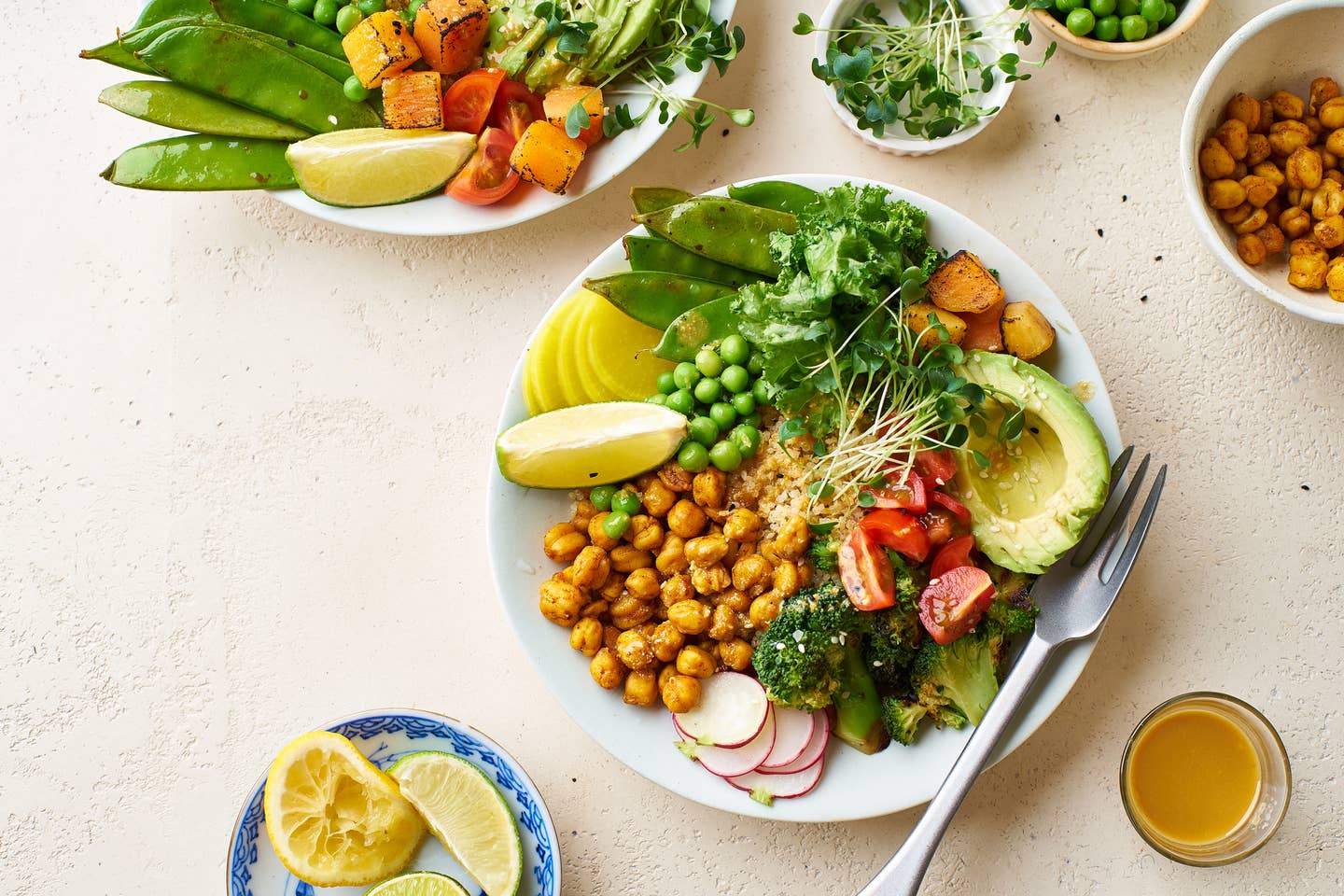
If You’re Allergic to Peanuts, Here’s the Surprising Food You Need to Avoid
If you have had a peanut allergy your whole life, you might think a plant-based diet full of nut-based milks, cheeses, and nut butter is off the table. And while a peanut allergy can be one of the more harrowing and frightening of allergies, since you never know what is lurking in your store-bought entree or restaurant meal, you can also rest assured there are plenty of foods you can safely eat, such as most other nuts.
But there are also foods you need to stay away from, including some you might not expect, such as lentils and other legumes. Here is exactly what the latest research says about peanut allergies, according to a top allergy specialist. But before you rely on what studies or anything you read online says, always check with your doctor and don't take chances with your health.
Peanut allergies are not necessarily related to other nuts
The peanut allergy can be misconstrued as being connected to other tree nuts, which for a plant-based eater would be a devastating blow to your food choices, especially since so much milk is almond-based and the best vegan cheeses are often made with cashew milk. The good news is there’s not as much danger as you might fear.
Allergist and immunologist Dr. Purvi Parikh, an allergist and immunologist with the Allergy & Asthma Network in New York City, explains the science behind classic peanut allergies, and how this reaction evolves from childhood to adulthood. Dr. Parikh, who was involved with the clinical trials for the COVID-19 vaccine approval process, revealed that most people affected by a peanut allergy should not have to worry about other tree nuts, unless they are unlucky enough to be allergic to them as well, but should watch out for another food: Legumes.
Peanuts are not actually from the nut family.
Despite its name, a peanut is not even classified as a nut. Peanuts are more closely related to lentils, beans, and the greater legume family. So if you're allergic to peanuts, it would be best to avoid all legumes, including beans, such as in rice and beans often found in Mexican food, and lentils (which are also added to soups). But when you're next shopping for plant-based milk substitutes or protein-packed snacks, you are likely to not get any pushback from your allergy doctor when you ask her about whether it's safe for you to drink almond milk or eat a delicious cashew cheese. But do ask her first, of course.
Allergies change through a person's life, according to Dr. Parikh, and for some people, a childhood allergy can diminish over time and be completely gone by adulthood. The body acclimates over continuous and long-term exposure to allergens, so someone who may have been deathly allergic as a baby or young child becomes less sensitive to it by the time they reach college, but the trick is to keep checking with your allergy specialist and getting sensitivity tests before eating a spoonful of peanut butter, she adds. It is important to keep tracking your body's changing relationship to food. Dr. Parikh emphasizes that it is important to see an allergist regularly, to know more about exactly what you can and cannot eat.
Here is Dr. Parikh's advice for going plant-based with a peanut allergy
The Beet: Should someone with a peanut allergy stay away from nuts or nut milk?
Dr. Purvi Parikh: Actually, the peanut is not really a nut, even though it is called that. They’re in the legume family. So they’re actually more closely related to lentils and certain beans. The good news is that if you have a peanut allergy usually for the most part you can eat other nuts.
Tree nuts are what we typically think of as nuts: Cashews, almonds, pistachios, walnuts, and what have you. Some people are unlucky and are allergic to both, but that’s a different story. If you are only allergic to peanuts, you don’t have to exclude these other nuts, especially if you are eating them with no problem. You just have to be careful that there’s no cross-contamination because a lot of times they’re all mixed in certain places. From a medical standpoint, they are very different.
The Beet: What should people avoid if they have a peanut allergy?
Dr.Parikh: Actually, legumes. But even then, some people are only allergic to peanuts and can eat other legumes with no problem. Again, this is why it’s important to sit down with a board-certified allergist to find out what you are truly allergic to and to find out what you can or can not eat because you might be avoiding foods that you don’t need to if that makes sense.
The Beet: You advise someone have an in-person appointment with an allergist?
Dr. Parikh: Yes. Absolutely. The importance of seeing an allergist in person is that that doctor can determine the source of your allergic reactions. This is important especially when it comes to cross-contamination specifically. Some allergic reactions could be caused by peanuts being in the same facility as cashew or almond-based products. It wouldn’t necessarily mean that you need to avoid these products, but it definitely means that it’s better to gain a better understanding.
The Beet: Some people grow out of childhood allergies and others don't. Why is that?
Dr. Parikh: Some people do grow out of it because their body becomes desensitized over the years. But until that happens, and even afterward, it's smart to carry an EpiPen, since you may develop a reaction to a bee sting or other allergen.
The Beet: Is there any cure for severe life-long peanut allergies?
Dr. Parikh: Finally for the first time ever we have a treatment for peanut allergies because before, for all food allergies you just had to avoid it. Just in the last year or two, the FDA approved desensitization for people with peanut allergies, so it’s called Palforzia which when combined with incremental exposure to peanuts can help to minimize a reaction. Desensitization doesn’t mean you just go out and eat peanuts or a Snickers bar, but what happens is small exposure makes you less allergic to peanuts over time.
This new treatment for peanut allergies requires working with a specialist to monitor a process of desensitization that does not cure the allergy, but reduces the life-threatening risk. When going to a restaurant or eating dinner with friends, the external factors that could cause cross-contamination can barely be predicted. This process of desensitization helps your body adapt to the allergen, letting out a sigh of relief when eating something that has any chance of crossing paths with a peanut; the factory, or the kitchen.
So it gives you an extra layer of protection if accidentally you come in contact with a peanut or eat a peanut. Some people are severely allergic and this type of treatment is for them.
The Beet: Does it make it so the peanut allergy is less life-threatening?
Dr. Parikh: It trains your immune system to not react as strongly, which is huge, because severe allergy causes anxiety for many food allergic patients, especially if they have very bad allergies that could potentially kill them. It gives them extra peace of mind that if they were to accidentally come into contact with it then less likely for something really bad would happen.
The Beet: Is there a difference between childhood and adulthood allergy development?
Dr. Parikh: Although children grow out of other allergies by the time they hit adulthood, the peanut allergy is extremely different. Even though some children grow out of it, the majority maintain their aversion to peanuts. On the flip side, adults very rarely will develop a peanut allergy. But adults can develop other allergies as we age.
The Beet: How frequently do people develop an allergy in adulthood versus childhood?
Dr. Parikh: The majority of nut allergies are developed in childhood. It is possible but it’s not very common. If you are an adult and can otherwise eat peanuts, you don't have to walk around worried that you might become allergic at any given time. Luckily those chances are rare, but it does happen. But it is much more common to develop other types of allergies as an adult, such as to fish and shellfish, those are more common.
The Beet: Are there other types of allergies that kids have and grow out of?
Dr. Parikh: There are certain allergens that most children grow out of–things like milk and eggs: 90% of kids who are allergic to dairy and eggs grow out of it. But with peanuts, not as many people grow out of it. Unfortunately, if you have it as a child there’s a very good chance that unfortunately, you'll have this allergy into adulthood. And then obviously if you develop an allergy as an adult you probably won't outgrow it. That is the problem. It really depends on which allergen it is or how severe the allergy is regarding your chances of outgrowing it or not.
The Beet: For those who haven't been to an allergist, what's the process of meeting with an allergist or immunologist?
Dr. Parikh: When you first come in an allergist will through your whole history. They will find out what foods, and what other things you might be having problems with, and what your reaction is to them. That part is crucial because many people are labeled as allergic to things, and this happened a lot with the vaccines too, what they describe is not truly an allergy.
Usually, an allergist can figure out from just that initial conversation, because we are trained to do so, what sounds more likely to be an allergy versus not. Cause a lot of things that are labeled allergies are not. And then what the allergist will probably do is do testing to confirm you are allergic or not allergic and how allergic you are.
The two types of allergy testing that we do is the skin prick test, which basically scratches the surface of your skin with various allergens like peanut, milk, eggs, whatever we’re suspecting, and if you are allergic, in about 20 minutes it will make a hive or mosquito bite type thing over that specific allergen, so we can figure out the same day whether you are allergic or not.
The second test that we will usually do or may add to it is a blood test. The blood test measures this antibody called IgE and that antibody is very specific for allergies. So it will say exactly which food you are allergic to similar to the skin test and then it will give a level of how allergic you are and the two together are helpful for that way we have an idea of what you are allergic to, how allergic you are and again it has to be based on the history.
Bottom line: Plant-based eaters don’t have to avoid all nut-based products, but Dr. Parikh suggests that everyone should visit an allergist. To know best what to eat and what to avoid, it is better not to guess. If you suffer from other types of allergies or experience seasonal allergies, there are healthy foods you can eat to help alleviate those symptoms.
To read about how to treat seasonal allergies, check out our article.
The Top 20 Veggies with the Most Protein
1. Soy Beans
Soybeans are a legume but they are such a great source of protein that we had to lead the veggie list with it. There is more protein in just one ounce of soybeans than a cup of sliced avocado! 1 cup equals Protein - 28.6g Calories - 298 Carbs - 17.1g Fiber - 10.3g Calcium - 175mg
2. Peas
If the pod, that peas are grown in, is split down the middle, that is an indicator they are ripe. Seeds inside the pod vary and can be green, white or yellow. 1 cup equals Protein - 8.6g Calories - 134 Carbs - 25g Fiber - 8.8g Calcium - 43.2 mg
3. Corn
Fresh corn is a great source of energy for those who like to stay active. Protein isn't all that corn has to offer. Corn provides the body with potassium and B vitamins. 1 cup equals Protein - 5.4g Calories - 177 Carbs - 123g Fiber - 4.6g Calcium - 4.9mg
4. Artichoke Hearts
Artichokes are part of the sunflower family. The fiber in artichoke hearts is great for supporting digestion. 1 cup equals Protein - 4.8g Calories - 89 Carbs - 20g Fiber - 14.4g Calcium - 35.2mg
5. Asparagus
If not properly stored, Asparagus tends to go bad quickly, To elongate freshness, put damp paper towels around the stems, or place the entire asparagus bunch in a cup of water (like flowers) to maintain freshness longer. 1 cup equals Protein - 4.4g Calories - 39.6 Carbs - 7.4g Fiber - 3.6g Calcium - 41.4mg
6. Brussel Sprouts
Brussel sprouts have more Vitamin C than an orange. If your Brussel sprouts have a rancid odor that is an indicator you overcooked them. The smell occurs because the sprouts are composed of a great amount of sulforaphane. 1 cup equals Protein - 4g Calories - 56.2 Carbs - 40g Fiber - 4g Calcium - 56.2mg
7. Broccoli
If you are trying to lose weight broccoli is a great addition to your diet because it consists of 90 water and is also high in fiber. 1 cup (chopped) equals Protein - 3.8g Calories - 54.6Carbs - 11.2g Fiber - 5.2g Calcium - 62.4mg
8. Mustard Greens
Mustard greens provide the body with tons of Vitamin A, Vitamin C, Vitamin K and fiber. Adding steamed mustard greens into your diet has been known to lower cholesterol and reduce inflammation. 1 cup equals Protein - 3.2 g Calories - 21 Carbs - 2.9g Fiber - 2.8g Calcium - 104mg
9. Avocado
Avocado is commonly mistaken as a vegetable but it is technically a fruit. This fruit had to be included in our veggie list because it isn't just tasty but super nutritious. Avocados are packed with protein but they are a great source of potassium and fiber. Avocados are a great addition to any salad, sandwich and even smoothie! 1 cup equals Protein - 3.0 g Calories - 240 Carbs - 12.8 g Fiber - 10.1g Calcium - 18 mg
Onions are an unappreciated food hero since they provide 20 percent of your daily Vitamin C and deliver an abundance of antioxidants that can reduce inflammation. 1 cup (chopped) equals Protein - 2.9g Calories - 92.4 Carbs - 21.3g Fiber - 2.9g Calcium - 46.2mg
11. Beets
The entire beetroot is edible including the leaves which contain loads of vitamin A, calcium, iron and potassium. Beetroot is high in sugar but is considered one of the most nutritious veggies used in salads and soups. 1 cup equals Protein - 2.8 g Calories - 74.8 Carbs - 17g Fiber - 3.4g Calcium - 27.2mg
12. Oyster Mushrooms
Oyster mushrooms are commonly seen in Chinese dishes. They grow best in a controlled environment indoors. Oyster mushrooms have so many nutrients to offer besides protein such as iron, calcium, zinc and folic acid. 1 cup (raw and sliced) equals Protein - 2.8g Calories - 37 Carbs - 5.6g Fiber - 2.0g Calcium - 2.6mg
13. Bok Choy
Bok Choy is a member of the mustard family. One of the oldest cultivated vegetables in the world, Bok Choy means "white vegetable” and is a great source of vitamins A, C, B6, K, and E, magnesium, potassium, iron, manganese, and calcium. 1 cup equals Protein - 2.7 g Calories - 20.4 Carbs - 3.1g Fiber - 1.7g Calcium - 158mg
14. Green Beans
Green beans are a great source of vitamins B, C and K, and minerals such as magnesium, iron and manganese. Green beans should be cooked before eating, to destroy lectins. China is the biggest grower of green beans in the world, exporting over 15 million tons a year. 1 cup equals Protein - 1.8 g Calories - 31 Carbs - 7 g Fiber - 2.7 g Calcium - 37 mg
15. Cauliflower
The most nutritious way to consume cauliflower is steamed. Don't get intimidated by orange, purple or green cauliflower. All three types have the same benefits as white cauliflower. 1 cup equals Protein - 2.2g Calories - 28.6 Carbs - 5.4g Fiber - 2.8g Calcium - 19.8mg
16. Turnip
You can eat the entire plant, root and leaves. The turnip root is high in vitamin C and the greens are high in vitamins A, C, E, B6 and K, believed to counter inflammation. Add turnip roots to soup, or mash them. Add them to salads. 1 cup equals Protein - 1.6g Calories - 28.8 Carbs - 6.3g Fiber - 5.0g Calcium - 197mg
17. Alfalfa Sprouts
Alfalfa sprouts might be little but they sure are powerful. Plus they're quick and easy to grow. They are loaded with Vitamin C, Vitamin K, Iron and more. But because they have been known to carry bacteria, make sure to fully cook alfalfa sprouts if you have a fragile immune system or are pregnant. 1 cup equals Protein - 1.3 g Calories - 8 Carbs - 0.7 g Fiber - 0.6 g Calcium - 10.6 mg
18. Tomatoes
Keep your tomatoes fresher for longer by storing them stem down. When exposed to sunlight the Vitamin C in a tomato will diminish. 1 cup equals Protein - 1.3g Calories - 26.8 Carbs - 5.8g Fiber - 1.8g Calcium - 14.9mg
19. Zucchini
Zucchini has an abundance of potassium, even more than a banana! The reason zucchini isn't high in calories is that it is made up of 95% water. 1 cup equals Protein - 1.2g Calories - 28.8 Carbs - 7.1g Fiber - 2.5g Calcium - 23.4 mg
20. Spinach
Spinach is filled with Vitamin A, Vitamin E, Vitamin K, fiber and protein. The best part about spinach is you can sauté it, blend it or eat it raw! Spinach is best grown in rainy and cool weather. 1 cup equals Protein - 0.9g Calories - 6.4 Carbs - 1.0 g Fiber - 0.6g Calcium - 27.7 mg
More From The Beet






